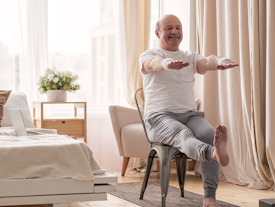The Best Chair Exercises To Improve Balance For Seniors
After a certain age, balance is one of the most valuable measures to determine one’s health and the capacity to live an independent life.
The chair exercises are easy to perform and prevent the seniors from stumbling and falling hence enhancing their stability while performing daily activities.
All these exercises can be done at home, the equipment needed is almost negligible and the exercises are not very rigorous on the joints.
When engaging in chair exercises, seniors will benefit from them by being able to increase their strength, flexibility, and coordination. This guide presents a list of chair exercises for seniors that they can adopt to improve balance.
Why is it important for seniors to practice chair exercises?
Only a few elderly people have good balance and this demands a need to enable the seniors to be mobile and avoid falling, which is the leading cause of injury in them.
When we mention exercise, most people often think of hitting the gym and doing hardcore forms of movement. However, exercise is not limited to high-energy activities. For aging individuals in particular, light forms of exercise can be highly feasible and effective.
Most chair exercises are useful to strengthen various muscles and enhance balance without having to necessitate the use of gym equipment. The mentioned exercises also call for the core muscles and improve coordination and flexibility, and factors that lead to ideal stability.
Moreover, most chair exercises do not harm the body and hence, seniors of different fitness levels or with health complications can do them.
7 Best Chair Exercises For Seniors To Enhance Balance
Here are the seven best exercises seniors can perform to improve balance using just a chair.
Back Leg Raises
Back leg raises are one of the most effective exercises that help in toning the lower back and gluteal set, which is the group of muscles that majorly contribute to balance. To perform this exercise sit back in a firm chair placing your feet flat on the ground.
Slowly swing one of the legs backward, at the back, and slightly upwards while ensuring that the knee is not bent and the toes are pointing downwards.
Wait for a couple of seconds and then slowly bring the leg down. It is recommended to perform this movement with 10-15 airlifts for the left leg and then 10-15 airlifts for the right leg.
Balancing Wand
Another useful exercise is the balancing wand; it is great for developing hand and eye coordination as well as stability in arms. For this exercise, you will require a light-hued stick or a cane.
Sit comfortably in a chair, and hold the wand either at the end of the handle, the middle of the shaft, or about one inch from the top with your right hand only.
One should try to balance it for as long a time as possible, for which one just needs to use his hand in a minimal way to make the stick stand upright. Switch hands and repeat. Do this exercise for about a few minutes targeting the left and right side.
Shoulder Rolls
Shoulder rolls are exercises placed in the rank of the most straightforward which help the upper body gain flexibility and the positioning of the shoulders. Place a chair in front of you and take a seat after that, remember that your back should be straight and your feet should be on the floor.
Next, move your shoulders in small, circular motions in the forward direction without jerking your body too much.
Moving forward perform 10-15 forward rolls; to complete the exercise turn around and perform the same number of backward rolls. This exercise assists in relaxing the muscles in the shoulders and neck.
Side Leg Raise
Sit erect on a chair with the legs drawn up to the seated part and the feet touching the ground. Slowly slide one of the legs out to the side without bending the knee.
Maintain the position, with your foot flat on the ground, for approximately five to ten seconds before returning your leg to the lying down position.
Continue this 10-15 times on each side. This chair exercise helps build the strength of the hip abductors so that the ability of a senior to maintain balance when moving from side to side is enhanced.
Single Limb Stance
Stand with your feet beside a chair and sit down appropriately with your feet resting on the floor surface. Slowly raise one leg from the floor and keep it in a raised position for as long as possible; as a minimum, 10 seconds.
Ensure that your back is straight, and your stomach muscles contracted. Slowly bring your foot down to the floor and flip your foot over, then do the same to your other foot.
This exercise assists in the improvement of balance and also the muscles of the legs and the belly area which is very essential in support and avoiding falls.
Toe Lifts
Stand as you place your feet flat on the floor with your back straight, preferably sitting on a chair. Next slowly raise the toes off the ground with the heels being anchoring on the ground. Bend at the elbows and hold for a few seconds, then lower your toes back to the ground.
Perform the above movement in 10-15 cycles. Toe lifts are effective in the build-up of the anterior tibialis muscle group since it is crucial in balancing and stability beginning with gaiting and throughout other activities.
Clock Reach
Sit on a chair with your feet on the floor. On the desk in front of you picture a clock. For the 12 o’clock position place one arm overhead and return to the middle. After that, extend your left hand from the center, toward the 3 o’clock position and come back to the center.
Same for the 6 and 9 o’clock positions. Do this approximately 10-15 reps with each arm. The clock reach exercise improves the flexibility and coordination of the upper extremities which are important when regaining balance and avoiding a fall.
Final Thoughts
The chair exercises for seniors mentioned above are among the most useful for elders because they help enhance balance. All these exercises are non-invasive and effective.
These movements offer an opportunity to improve strength, coordination, and even confidence hence improving the quality of life of the elderly by being more independent.










